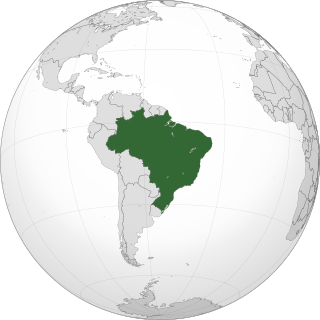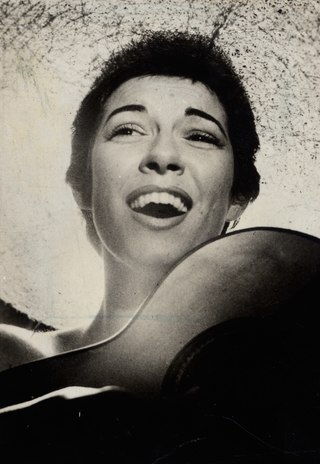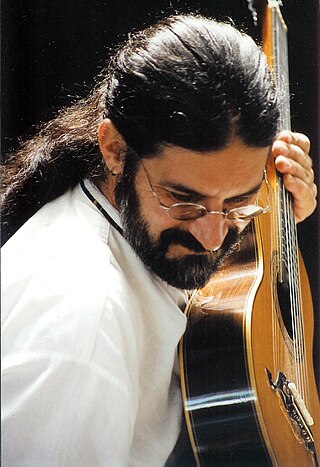Related Research Articles

Samba is a name or prefix used for several rhythmic variants, such as samba urbano carioca, samba de roda, amongst many other forms of samba, mostly originated in the Rio de Janeiro and Bahia states. Samba is a broad term for many of the rhythms that compose the better known Brazilian music genres that originated in the Afro-Brazilian communities of Bahia in the late 19th century and early 20th century, having continued its development on the communities of Rio de Janeiro in the early 20th century. Having its roots in the Afro-Brazilian Candomblé, as well as other Afro-Brazilian and Indigenous folk traditions, such as the traditional Samba de Caboclo, it is considered one of the most important cultural phenomena in Brazil and one of the country's symbols. Present in the Portuguese language at least since the 19th century, the word "samba" was originally used to designate a "popular dance". Over time, its meaning has been extended to a "batuque-like circle dance", a dance style, and also to a "music genre". This process of establishing itself as a musical genre began in the 1910s and it had its inaugural landmark in the song "Pelo Telefone", launched in 1917. Despite being identified by its creators, the public, and the Brazilian music industry as "samba", this pioneering style was much more connected from the rhythmic and instrumental point of view to maxixe than to samba itself.

The music of Brazil encompasses various regional musical styles influenced by European, American, African and Amerindian forms. Brazilian music developed some unique and original styles such as forró, repente, coco de roda, axé, sertanejo, samba, bossa nova, MPB, gaucho music, pagode, tropicália, choro, maracatu, embolada, frevo, brega, modinha and Brazilian versions of foreign musical styles, such as rock, pop music, soul, hip-hop, disco music, country music, ambient, industrial and psychedelic music, rap, classical music, fado, and gospel.

Bossa nova is a relaxed style of samba developed in the late 1950s and early 1960s in Rio de Janeiro, Brazil. It is mainly characterized by a calm syncopated rhythm with chords and fingerstyle mimicking the beat of a samba groove, as if it was a simplification and stylization on the guitar of the rhythm produced by a samba school band. Another defining characteristic of the style is the use of unconventional chords in some cases with complex progressions and "ambiguous" harmonies. A common misconception is that these complex chords and harmonies were derived from jazz, but samba guitar players have been using similar arrangement structures since the early 1920s, indicating a case of parallel evolution of styles rather than a simple transference from jazz to bossa nova. Nevertheless, bossa nova was influenced by jazz, both in the harmonies used and also by the instrumentation of songs, and today many bossa nova songs are considered jazz standards. The popularity of bossa nova has helped to renew samba and contributed to the modernization of Brazilian music in general.
Samba may also refer to:
Carioca is a demonym used to refer to residents of the City of Rio de Janeiro, in Brazil and their culture.

Brazilian Portuguese is the set of varieties of the Portuguese language native to Brazil and the most influential form of Portuguese worldwide. It is spoken by almost all of the 203 million inhabitants of Brazil and spoken widely across the Brazilian diaspora, today consisting of about two million Brazilians who have emigrated to other countries. With a population of over 203 million, Brazil is by far the world's largest Portuguese-speaking nation and the only one in the Americas.

The Caipira viola or Caipira guitar, is a Brazilian ten-string guitar with five courses of strings arranged in pairs. It is a variation of the Portuguese viola that developed in the state of São Paulo during the colonial period, serving as a basis for Paulista music, especially for subgenres of Caipira folklore, such as moda de viola, caipira pagode, catira, etc.

Festas Juninas, also known as festas de São João for their part in celebrating the nativity of St. John the Baptist, are the annual Brazilian celebrations adapted from European Midsummer that take place in the southern midwinter. These festivities, which were introduced by the Portuguese during the colonial period (1500–1822), are celebrated during the month of June nationwide. The festival is mainly celebrated on the eves of the Catholic solemnities of Saint Anthony, Saint John the Baptist, and Saint Peter.

Paulinho Nogueira was a Brazilian guitarist, composer and singer.

Caipiras are the traditional population of the Brazilian states of São Paulo, Goiás, Minas Gerais, Mato Grosso, Mato Grosso do Sul, and Paraná. All the regions where Caipira culture predominates are grouped into a cultural area, known since the 20th century as Paulistania.
The Bachianas Brasileiras are a series of nine suites by the Brazilian composer Heitor Villa-Lobos, written for various combinations of instruments and voices between 1930 and 1945. They represent a fusion of Brazilian folk and popular music on the one hand and the style of Johann Sebastian Bach on the other, as an attempt to freely adapt a number of Baroque harmonic and contrapuntal procedures to Brazilian music. Most of the movements in each suite have two titles: one "Bachian", the other Brazilian.

Ignez Magdalena Aranha de Lima Barroso was a Brazilian sertanejo singer, guitarist, actress, TV presenter, librarian, folklorist and teacher.
Música sertaneja or sertanejo is a music style that had its origins in the countryside of São Paulo in the 1920s. Its contemporary developments made it the most popular genre in the country, particularly throughout the southern, southeastern, and center-western interior. Subgenres include caipira, romântico, and universitário.
Sambalanço Trio was a Brazilian samba-jazz group formed by Cesar Camargo Mariano (piano), Humberto Clayber (bass) and Airto Moreira (drums). The band started to play in 1964 and lasted for about two years. Their albums are considered some of the most important works of that period and influenced many other groups of samba and jazz.

Braz Roberto da Costa, known professionally as Braz da Viola, is a Brazilian multi-instrumentalist musician, luthier, conductor and teacher. He runs workshops of viola caipira in several cities in Brazil. He played with several guitar players in Brazil, such as Roberto Corrêa, Paulo Freire, Renato Andrade, Pereira da Viola, Ivan Vilela and dual Zé Mulato and Cassiano. He worked with Inezita Barroso, when the singer appeared accompanied by the Orquestra de Viola Caipira de São José dos Campos.
Caipira pagode, is a variant of Caipira music originating in the state of Paraná.
Caipira is a dialect of the Portuguese language spoken in localities of Caipira influence, mainly in the interior of the state of São Paulo, in the eastern south of Mato Grosso do Sul, in the Triângulo and southern Minas Gerais, in the south of Goiás, in the far north, center and west of Paraná, as well as in other regions of the interior of the state. Its delimitation and characterization dates back to 1920, with Amadeu Amaral's work, O Dialecto Caipira.
The Italo-Paulista (Íntalo-baolista), also known as Paulistalian, is a language that blends Italian dialects with the Caipira dialect. It was widely spoken by Italian immigrants and their descendants until the early 1960s in São Paulo State, especially in the Greater São Paulo region. Italo-Paulista or Paulistalian was commonly spoken on the streets of São Paulo.

Renato Teixeira de Oliveira is a Brazilian singer-songwriter. He is a representative of sertanejo music and folk rock, linked to the caipira culture and dialect. Teixeira is the author of several hit songs including "Romaria", which was notably covered by Elis Regina in her eponymous 1977 album. Other hit songs by Teixeira were "Dadá Maria" and "Tocando em Frente", later sung also by Maria Bethânia. Teixeira won twice the Latin Grammy Award: in 2015 for Best Sertaneja Music Album, with Sérgio Reis, and in 2016, with Sater. His album +AR was ranked as the 44th best Brazilian album of 2018 by the Brazilian edition of Rolling Stone magazine and among the 25 best Brazilian albums of the second half of 2018 by the São Paulo Association of Art Critics.
Mandi & Sorocabinha was the first commercial sertanejo duo in Brazil. It was formed by Manuel Rodrigues Lourenço, the Mandi and Olegário José de Godoy, the Sorocabinha.
References
- ↑ Amaral, Fundação Ubaldino do. "A morada do samba caipira". Jornal Cruzeiro do Sul (in Brazilian Portuguese). Retrieved 2024-12-07.